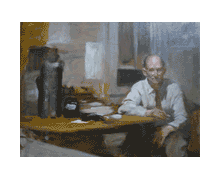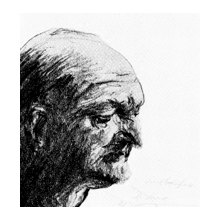
Emil Goldfus/Rudolf Abel
Emil Goldfus rented an artist's studio in the Orvington Studios in Brooklyn. Burt Silverman rented a studio in the same building, which became one of the common meeting places for the group that would mount the Realist View show in 1961. Burt met Emil, and introduced him to the others who gathered at his studio. As Daniel said, "Time went on, and he (Emil) became part of the crowd," even though Emil was more than 20 years older than most members of the group.



Images of Emil by Burt Silverman
While the younger artists did not regard Emil as being especially talented, he did share their interest in realist art, and they found him intelligent and knowledgeable. However, they also found him a bit secretive, and some had a few unanswered questions about him.


Images of Emil by Shelly Fink
On June 21, 1957, the reasons for Emil's secretive nature started to become more obvious after the FBI arrested him. Emil, under the Russian identity of Colonel Rudolf Abel, stood trial in New York City Federal Court in October of 1957, indicted as a Soviet spy. He had trained in the Soviet Union in 1946 to operate in the United States, then traveled to Canada and entered the U.S. in November of 1947.

Image of Emil by David Levine
After being convicted on three counts in late October of 1957, and serving time in prison, Emil/Abel, whose real name was Vilyam (Willie) Genrikhovich (August) Fisher, was exchanged for CIA U-2 pilot Gary Powers and an American student named Frederic Pryor. After his return to Moscow, he continued to work as a trainer for the KGB and was rewarded with the Order of Lenin.

Emil/Abel's 1957 Mug Shot
In 1990, the USSR issued a stamp with Fisher's image to honor Rudolf Abel, even though that name was an alias Fisher adopted on his arrest, and it belonged to a lesser known NKVD agent who had died a couple of years before Fisher's arrest. Fisher died of lung cancer in 1971 and was buried next to his father in the New Donskoy Cemetery in Moscow.

Rudolf Abel 1990 commemorative stamp











